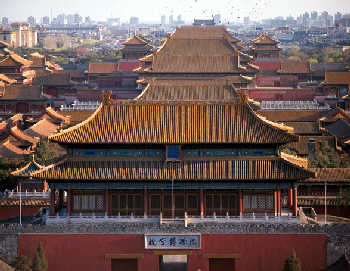
Like overseas sanctuaries and the pyramids in ancient Egypt, the Forbidden City in Beijing enjoys a set of rules governing the choice of architectural dimensions. Fu Xinian, an architectural historiographer, tried to decipher the mystery of numbers by carefully measuring the area of every courtyard and the exact location of individual places within the complex.
The Forbidden City: the Mystery of Numbers
With careful examination, Fu Xinian concluded that the layout of individual courtyards in the Forbidden City was designed according to a certain ratio.
Fu started with the courtyard in the rear composed of 2 residential dwellings of emperors and concubines, and the courtyard in the front consisting of 3 grand halls where emperors handled official businesses.
According to his measurement, the rear courtyard is 218 meters long and 118 meters wide, and the front courtyard is 437 meters long and 234 meters wide. As a result, the ratios of the length to the width in both courtyards turn out to be the same, reaching 6 to 11, and the courtyard in the front is twice as long and wide as the rear courtyard, which consequently means the front courtyard is 4 times the size of the rear one.
Another example is the structure of the Hall of Supreme Harmony (Taihe Dian), which displays overwhelming imperial power. It was designed according to the 9-by-5 standard. There are 9 bays (literally rooms that are each enclosed by 4 poles) in length and 5 bays in width. Therefore, the ratio of its length and width reaches 9 to 5.
Both 9 and 5 carried special meanings in ancientChinese architecture. Numbers can be divided into odds and evens, which fall into the categories of Yang and Yin respectively according to the Yin-Yang principle (concerning opposing elements). Within the odds less than 10, 9 is the largest one and 5 ranks in the middle. Accordingly, both 9 and 5 connoted the supreme imperial power in ancient China.
Why are there some exceptions?
Tourists may find that there are 11 instead of 9 bays in length in today's Hall of Supreme Harmony. The reason lies in the fact that the original Hall of Supreme Harmony was destroyed by the end ofMing Dynasty(1368-1644) and repaired in 1669 under the reign of the EmperorKangxiin theQing Dynasty(1644-1911). Due to the lack of a specific special superior wood during the restoration, the width was adjusted to 11 bays.
The number of the beasts engraved in the ridges of the imperial palaces was usually 9. The ridges of the Hall of Supreme, however, are embossed with 10 beasts.
Another riddle was the number of doornails. It was an established rule to have all together 81 nails on every door in the imperial palace. There are usually 9 rows and 9 nails in every row. However, on some doors in the Forbidden City, there were only 8 rows, which obviously were not design or building mistakes.
The Golden Section Rule
The Golden Section has been referred to as the Divine Proportion, or the Golden Rectangle. This proportion has been demonstrated in the Greek architecture of the Parthenon and the Renaissance architecture in Florence.
Fu Xinian's measurement shows the design and construction of the Forbidden City complies with the Golden Section Rule. The courtyard where the Gate of Supreme Harmony lies in is 200 meters long and 130 meters wide, with a ratio of width to length reaching 0.65 (65 to 35). This number is somewhere near 0.618, the Golden Section Ratio.
Also, with the distance from the Da Ming Gate to the Jing Mountain reaching 2.5 kilos, and the distance from the Da Ming Gate to the center of the Hall of Supreme Harmony hitting 1.5045 kilos, the ratio of 1.5045 to 2.5 amounts to 0.618, which is exactly the Golden Section Ratio.
There is no clear proof that the design of Chinese palaces was influenced by Western architectural ideas. Anyway, the employment of the Golden Section Rule in both China and the West is a testifies to its reasonableness, and also reveals that human beings, regardless of nationalities, share commonness in the pursuit of beauty.
(Source: chinaculture.org)

Copyright ©1999-2011 Chinanews.com. All rights reserved.
Reproduction in whole or in part without permission is prohibited.